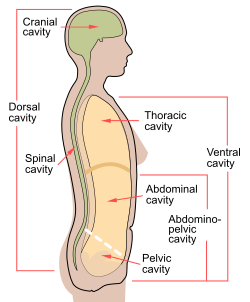Wall of the abdomen
| Abdominal wall | |
|---|---|

Body cavities
|
|

Diagram of sheath of Rectus above the arcuate line.
|
|
| Details | |
| Identifiers | |
| Latin | paries abdominalis |
| FMA | 299989 |
|
Anatomical terminology
[]
|
|
In anatomy, the abdominal wall represents the boundaries of the abdominal cavity. The abdominal wall is split into the posterior (back), lateral (sides) and anterior (front) walls.
There is a common set of layers covering and forming all the walls: the deepest being the visceral peritoneum, which covers many of the abdominal organs (most of the large and small intestines, for example), and the parietal peritoneum- which covers the visceral peritoneum below it, the extraperitoneal fat, the transversalis fascia, the internal and external oblique and transversus abdominis aponeurosis, and a layer of fascia, which has different names according to what it covers (e.g., transversalis, psoas fascia).
In medical vernacular, the term 'abdominal wall' most commonly refers to the layers composing the anterior abdominal wall which, in addition to the layers mentioned above, includes the three layers of muscle: the transversus abdominis (transverse abdominal muscle), the internal (obliquus internus) and the external oblique (obliquus externus).
In human anatomy, the layers of the abdominal wall are (from superficial to deep):
The surface contains several ligaments separated by fossae:
...
Wikipedia
